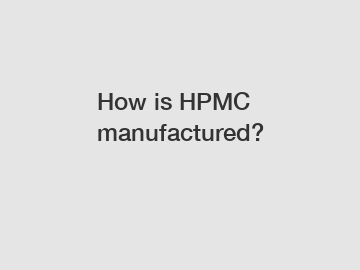How is HPMC manufactured?
HPMC, or hydroxypropyl methylcellulose, is a versatile polymer that finds applications in various industries such as pharmaceuticals, food, construction, and cosmetics. HPMC is typically used as a thickening agent, stabilizer, or emulsifier in these industries. The manufacturing process of HPMC involves several steps and precise conditions to ensure the desired quality and properties of the polymer.
**Stage 1: Cellulose Extraction**.

The first stage in manufacturing HPMC involves the extraction of cellulose from wood pulp or cotton linters. Cellulose is a natural polymer found in plant cell walls and serves as the raw material for producing HPMC. To extract cellulose, the wood pulp or cotton linters are treated with a combination of alkali and acid solutions to remove impurities and isolate the cellulose fibers.
**Stage 2: Etherification**.
Once cellulose is extracted, it undergoes an etherification process to introduce hydroxypropyl and methyl groups onto the cellulose backbone, converting it into HPMC. This process involves reacting the cellulose with propylene oxide and methyl chloride under controlled conditions of temperature, pressure, and pH. The reaction results in the substitution of hydroxypropyl and methyl groups at the hydroxyl sites of the cellulose molecule, leading to the formation of HPMC.
**Stage 3: Purification and Drying**.
After etherification, the crude HPMC product is purified to remove any unreacted chemicals, byproducts, and impurities. The purification process may involve washing, filtration, and drying of the HPMC to obtain a pure white powder or granules. Drying is crucial to remove any residual moisture and ensure the stability and shelf-life of the final HPMC product.
**Stage 4: Quality Control**.
Quality control is an essential part of the manufacturing process of HPMC to ensure that the final product meets the required specifications and standards. Various tests are conducted to assess the purity, viscosity, particle size, and other properties of the HPMC product. These tests help in determining the quality, consistency, and performance of the polymer in different applications.
**The Role of Equipment and Technology in HPMC Manufacturing**.
The manufacturing of HPMC involves the use of specialized equipment and technology to carry out the conversion of cellulose into HPMC efficiently. Reactors, pumps, mixers, and drying equipment are essential for each stage of the manufacturing process. Moreover, advanced control systems and automation help in monitoring and controlling the process parameters to optimize the yield and quality of HPMC.
**Conclusion**.
In conclusion, the manufacturing process of HPMC is a carefully controlled and monitored process that involves the extraction of cellulose, etherification, purification, and quality control. Each stage of the process plays a crucial role in determining the characteristics and performance of the final HPMC product. By following the specified procedures and utilizing the right equipment and technology, manufacturers can produce high-quality HPMC for various industrial applications.
For more information on HPMC manufacturing or to inquire about our products, please contact us.
For more information, please visit china hebei HPMC manufacture.



